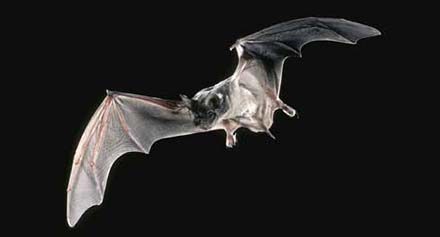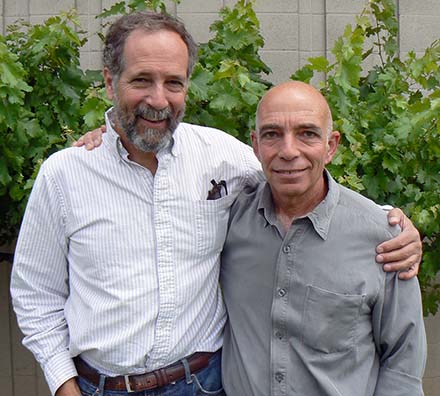Read original article here:
Bats Battle Bugs in California Vineyards – Wines & Vines – Wine Industry News Headlines.
07.05.2011
Bats Battle Bugs in California Vineyards by Jon Tourney
Lodi grapegrowers hear how bats may target sharpshooters, grapevine moths, thrips and other pests

Common in California, the Mexican free-tailed bat is a general insect eater, but most often it feeds on aerial insects at night, such as moths and flies. Source: UC IPM
Lodi, California — The role of bats in battling bugs in vineyard ecosystems is formally recognized in the Lodi Rules for Sustainable Winegrowing and the California Sustainable Winegrowing Practices programs. The Lodi Winegrape Commission held a grower meeting last week focused on bats for integrated pest management (IPM) and ways to encourage their presence in vineyards.
Guest speaker and bat expert Dr. Dave Johnston, senior wildlife ecologist with H.T. Harvey & Associates Ecological Consultants, Los Gatos, California, summarized the benefits of bats: “Every bat eats its weight in insects every night during the growing season.” Johnston, also an adjunct professor in biological science at San Jose State University and co-author of the California Bat Conservation Plan, has conducted bat surveys and consulted on bat habitat plans for government agencies and corporations in California.

Bat ecologist Dave Johnston of H.T. Harvey & Associates Ecological Consultants, and new Lodi Winegrape Commission sustainable viticulture director Walt Chavoor presented information on bat IPM at the Lodi grapegrower meeting.
Bat diversity and ecology
Johnston provided an overview of bat ecology and natural history, both worldwide and locally. Of the nearly 5,000 species of mammals in the world, nearly 1,200 are bats. Bats range from the size of a bumblebee to the largest species, which has a six-foot wingspan. Diets include nectar and pollen, small insects, frogs, fish; larger species catch and eat chickens.
North American bat species are mostly similar in size and primarily eat insects. They use echolocation to find and catch prey. Bats are long-lived: Some are known to live 35 years, but little is known about ages of California bats.
Johnston said, “Every bat species is different, and they have filled many different ecological niches.” He noted that even different individuals in the same species and colony specialize in different types of prey within the same foraging area.
Johnston advised, “In order to optimize habitat in your vineyard for bats, you should understand the natural history and life cycles of the bats in your area and the life cycles of the insects they can feed on in the vineyard.”
Bats in relation to IPM in agriculture have been studied most in Texas. One recent study of four agricultural counties in Texas estimated that the value of bats in controlling insects amounts to $8.5 million per year.
California bats
Johnston discussed three species of bats commonly seen in Northern California grapegrowing regions. The most important, and potentially most beneficial, is the Mexican free-tailed bat (Tadarida brasiliensis), also called the Brazilian free-tailed bat. It is a general insect eater, but most often it feeds on aerial insects at night, such as moths and flies.
The pallid bat (Antrozous pallidus) eats grasshoppers, katydids, moths, centipedes and spiders, and sometimes it shares roosting sites with the Mexican free-tailed bat (MFTB). The Yuma myotis (Myotis yumanensis) specializes in aquatic insects like caddis flies, alder flies and mayflies, roosting in riparian areas and near water.
Johnston listed the following grape insect pests as potential MFTB food: grape leaffolder, grape bud beetle, light brown apple moth, blue green sharpshooter, glassy-winged sharpshooter, western grapeleaf skeletonizer and grape orange tortrix. Since the European grapevine moth flies at dusk, it is also a potential food source. The MFTB can also eat thrips, and will eat mosquitoes if present, but prefers larger food sources like moths.
Johnston said MFTBs range throughout the region as part of their normal lifestyle. “They are looking for optimal temperatures, and they are looking for bugs,” he summarized. “Mexican free-tailed bats have big colonies in the Central Valley during the summer; many leave in the winter and go to coastal areas where winter temperatures are more moderate,” he said.
They mate in the fall and form winter colonies. Johnston explained, “Our bats overwinter, but they don’t hibernate completely like bats in colder climates. During winter, they will forage every few days, instead of every day as they do in summer.” Beginning in February, females establish maternity colonies where they remain and raise young until about August, when the young bats can forage on their own. A female bears only one offspring per year.
These bats are very temperature-dependent in terms of roosting and nesting sites. In summer, they want a temperature range of 85° to 105°F, particularly for maternity nesting colonies. In winter, they want cooler temperatures and will go into torpor for short periods.
Bat habitat for vineyards
Although plans and directions for building bat houses can be found from several sources, manmade bat houses have had mixed results. Even under good conditions, it can take one to four years for bats to locate and start roosting in a bat house if they find it acceptable—and as long as 10 years for a resident colony to establish itself. Johnston asked for a show of hands from Lodi grower attendees about their experiences with bat houses. Ten of the growers have bat houses located in their vineyards, but only two of these are currently occupied.
Johnston recommended maintaining riparian vegetation and oak trees in the vicinity to provide roosting sites for bats, which will occupy tree cavities and roost under tree bark during daylight hours. They also roost in rock outcroppings and commonly can be found in the attics of barns or other structures or in tile roofs.
Based on his observations, Johnston said stand-alone bat houses generally don’t work very well. At taching bat houses or roosting slats to an existing structure can take advantage of the structure’s thermal properties, maintaining heat during nighttime hours. He said concrete structures work well because they retain heat, but metal structures can become too hot.
Johnston recommended that slat or crevice spaces in bat structures be 0.75-inches wide. He also suggested bat houses be placed on the building’s east-facing side to receive light and heat and raise temperatures as soon as possible in the morning.
Johnston estimated that Mexican free-tailed bats have an average nightly foraging range of 10 square miles. This bat can fly as fast as 60 mph, traveling long distances to find insects if required. As a result, regional colonies can benefit many vineyards and farms, even if bats do not roost or reside on a particular vineyard property.
Johnston has been a consultant for CalTrans, assisting in bat habitat mitigation strategies related to roosting and colony sites under highway bridges. He was involved in the reconstruction of the Franklin Boulevard Bridge in south Sacramento County, within the Lodi appellation, which housed a large bat colony prior to rebuilding. Roosting crevices incorporated into the new bridge’s underside now house more than 20,000 bats, based on a survey Johnston conducted earlier this year.
Bat information resources
• Bat Conservation International: batcon.org
• University of California IPM website: ipm.ucdavis.edu
• UC Agriculture and Natural Resources Publication No. 21636 “Songbird, Bat and Owl Boxes”.
Chavoor Named LWC Sustainable Vit director
Walt Chavoor, the Lodi Winegrape Commission’s new sustainable viticulture director, was also at this week’s meeting, getting acquainted with area grapegrowers. Chavoor has worked in vineyard management in California for more than 30 years.
He spent the past 11 years as a vineyard manager in western Sonoma County for 4 million-case Kendall-Jackson Wine Estates. His previous employment includes stints with 40,000-case Hanna Winery in Sonoma County, 150,000-case Parducci Wine Cellars in Mendocino and Lake Counties, and 15,000-case Monticello Vineyards in Napa Valley.
A native of Los Angeles, Chavoor grew up in an urban environment but always wanted to be a farmer. He studied plant science at California State University, Fresno, and began his ag career as a field laborer in the Central Valley. He worked in Monterey County before managing vineyards in the North Coast. He has long had an interest in organic farming.
Chavoor commented, “I’ve been lucky to work in the wine industry and watch it grow in California over the past 30 years. One of the great things about Lodi growers is that they are mostly owner/operators; they are very hands-on and are actively involved in day-to-day farming.”
Citing the fact that many Lodi growers are fourth- and fifth-generation family farmers, Chavoor said, “I think it makes a difference in their attitude toward sustainability. They want to leave their vineyards and regional environment in good condition and productive for their kids.”
Copyright © Wines & Vines [reprinted with permission]
